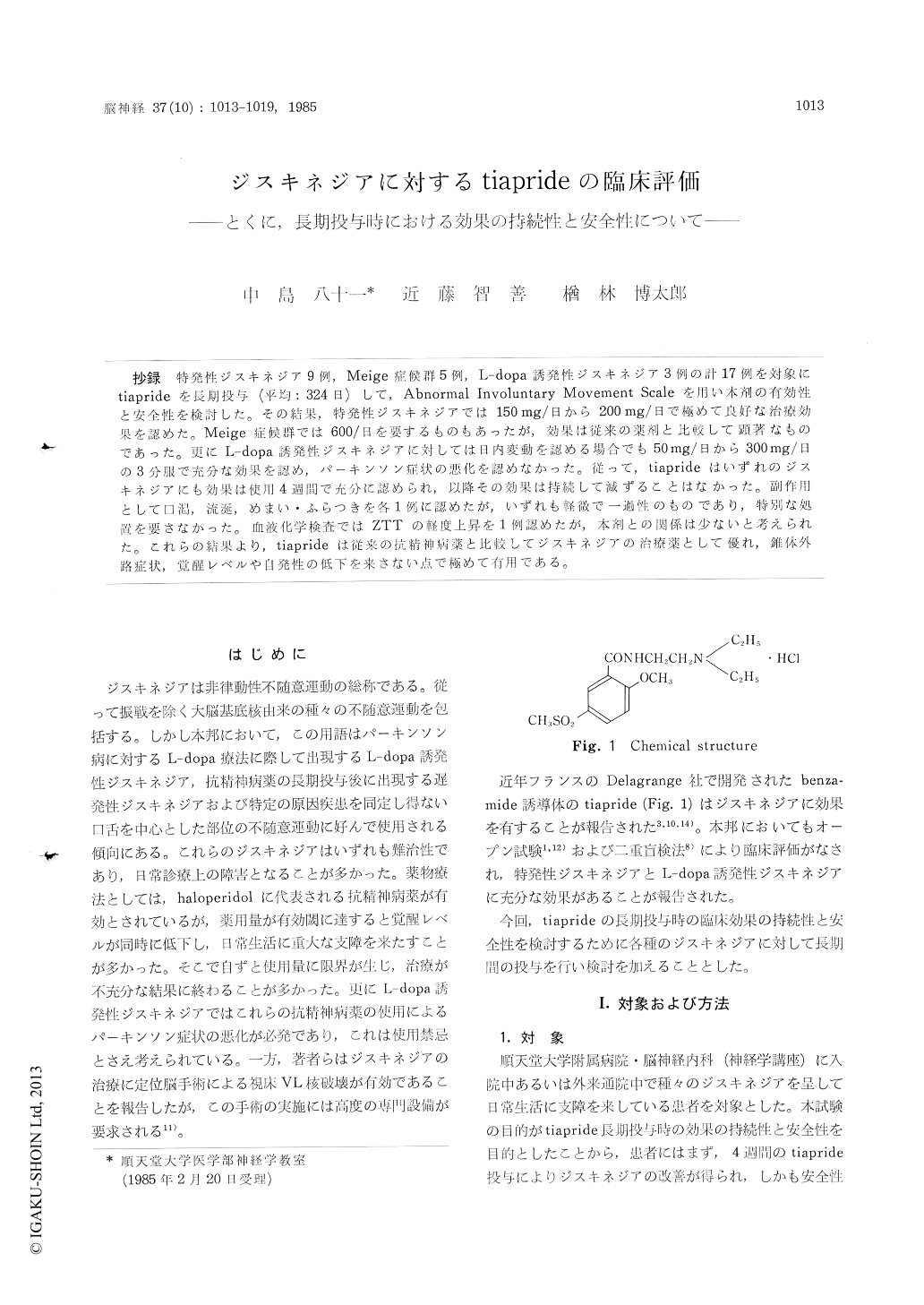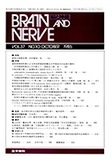Japanese
English
- 有料閲覧
- Abstract 文献概要
- 1ページ目 Look Inside
抄録 特発性ジスキネジア9例,Meige症候群5例,L-dopa誘発性ジスキネジア3例の計17例を対象にtiaprideを長期投与(平均:324日)して,Abnormal Involuntary Movement Scaleを用い本剤の有効性と安全性を検討した。その結果,特発性ジスキネジアでは150 mg/日から200 mg/日で極めて良好な治療効果を認めた。Meige症候群では600/日を要するものもあったが,効果は従来の薬剤と比較して顕著なものであった。更にL-dopa誘発性ジスキネジアに対しては日内変動を認める場合でも50 mg/日から300 mg/日の3分服で充分な効果を認め,パーキンソン症状の悪化を認めなかった。従って,tiaprideはいずれのジスキネジアにも効果は使用4週間で充分に認められ,以降その効果は持続して減ずることはなかった。副作用として口渇,流涎,めまい・ふらつきを各1例に認めたが,いずれも軽微で一過性のものであり,特別な処置を要さなかった。血液化学検査ではZTTの軽度上昇を1例認めたが,本剤との関係は少ないと考えられた。これらの結果より,tiaprideは従来の抗精神病薬と比較してジスキネジアの治療薬として優れ,錐体外路症状,覚醒レベルや自発性の低下を来さない点で極めで有用である。
Tiapride, a substituted benzamide derivative having chemical structure similar to sulpiride and metoclopramide, has been demonstrated to be a selective dopamine receptor blocking agent of the central nervous system, especially the D2-receptor.
The purpose of present study was to investigate efficacy and safety of Tiapride in patients with various forms of dyskinesia in long-term treatment.
Severity of dyskinesia was rated using the Ab-normal Involuntary Movement Scale (AIMS) de-veloped by the National Institute of Mental Health (U. S. A.). Rating was made before, on week 1, 2 and thereafter at 1 to 2 month interval. Adverse reaction was also checked on severity, onset, course and treatment. In patients with parkin-sonism, Hoehn Yahr's Grading was also adminis-tered. Based on these recording, overall improve-ment rating (OIR), overall safety rating (OSR) and usefulness, taken OIR and OSR in combination into account, were evaluated at the end of week 4 and at study completion.
The results are summarized as follow;
Tiapride was given to 17 patients aged 39 to 81 (average : 62.8) in total, 9 with idiopathic dyskinesia, 5 with Meige's syndrome and 3 with parkinsonism developing dyskinesia induced by L-DOPA. Daily doses were ranged from 50 mg in patients with parkinsonism to WU mg in those with Meige's syndrome. Administration period was 35 to 748 days (average: 324 days).
1. Overall improvement rating (OIR)
OIR showed that Tiapride was "markedly im-proved" in 3 patients, "moderately improved" in 10 and "slightly improved" in 4 on week 4, in-creasing up to "markedly improved" in 8, "mod-erately improved" in 6 and "slightly improved" in 3, respectively at study completion. By diag-nosis Tiapride was "markedly improved" in 3 patients with idiopathic dyskinesia, 1 with dys-kinesia induced by L-DOPA and 4 with Meige's syndrome. Above of all it was striking that Tia-pride brought markedly to moderately improve-ment in all 5 patients with Meige's syndrome, which was refractory to any treatment tried.
2. Effect on parkinsonism
In 3 parkinsonian patients with dyskinesia in-duced by L-DOPA, there was no change in Hoehn Yahr's Grading after treatment with Tiapride. Moreover in 2 patients with idiopathic dyskinesia where parkinsonian symptoms had been experien-ced with previous administration of haloperidol, occurrence of parkinsonian symptoms wasn't observed.
3. Overall safety rating (OSR)
OSR revealed that there were no adverse reac-tions in 13 out of the 17 patients given Tiapride. Dry mouth and salivation, slight and transient, were encountered in 1 patient respectively. Mod-erate dizziness was noted in 1 patient. Slight elevation in ZTT value, though judged "unlikely related to Tiapride treatment", was seen in 1 pa-tient. However in any patient with these adverse reactions, reduction in doses or withdrawal of Tiapride was not required.
4. Usefulness
Usefulness rating showed that Tiapride was "very useful" in 3, "useful" in 10 and "slightly useful" in 4 on week 4, increasing up to "very useful" in 8, "useful" in 6 and "slightly useful" in 3, respectively at study completion.
It was concluded from this study that Tiapride can be recommended as a drug of choice in pa-tients with various forms of dyskinesia including those of idiopathic origin, induced by L-DOPA and Meige's syndrome.

Copyright © 1985, Igaku-Shoin Ltd. All rights reserved.


